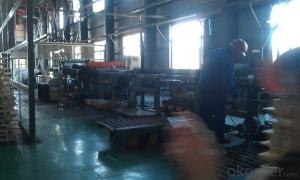Quality Tin Free Steel TFS Coils
- Loading Port:
- China Main Port
- Payment Terms:
- TT OR LC
- Min Order Qty:
- -
- Supply Capability:
- -
OKorder Service Pledge
OKorder Financial Service
You Might Also Like
Tin Free Steel (TFS)
Is also known as chromed steel, as it is obtained by coating the metal base (low-carbon steel) with an ultra-thin layer of metallic chrome and then with a chromium oxide layer.This steel product was developed to meet economic requirements, and excels tinplate in paintability, paint adhesion, and economy. It is widely used for making beverage cans and 18-liter cans. It is also used for making photographic film cases and as a protective material for optical fiber cables.
Our TFS Specification:
Standard: AISI, ASTM, BS, DIN, GB, JIS
Material: MR,SPCC
Thickness:0.15mm - 0.45mm
Width: 600mm -1150mm
Temper: T1-T5
Annealing: BA & CA
Coil Inner Diameter: 508mm
Weight: 6-10 tons/coil 1~1.7 tons/sheets bundle
Oil: DOS
Surface: Finish,bright,stone,matte,silver
Packing:
1、For sheets: plastic or waterproof paper, metallic cover and angles, steel strips,wooden pallet.
2、For Coils: plastic or waterproof paper,plastic protect plate,steel strips.
Both Prime and Second Quality Are Available!!!
- Q:Cookies with tinplate packaging has what advantage
- Tinplate has obvious superiority compared with other packaging materials.
- Q:Can tinplate be used for packaging frozen foods?
- Yes, tinplate can be used for packaging frozen foods. It has excellent durability and resistance to temperature fluctuations, making it suitable for preserving the quality and freshness of frozen food products. Additionally, tinplate offers a high level of protection against moisture, light, and oxygen, further ensuring the integrity of the frozen food during storage and transportation.
- Q:What are the main competitors of tinplate in the packaging industry?
- The main competitors of tinplate in the packaging industry include aluminum, plastic, and glass.
- Q:What are the different coating options for tinplate?
- Some of the different coating options for tinplate include tin-free steel (TFS), electrolytic tinplate (ETP), and tin coating with different grades or thicknesses.
- Q:How does tinplate affect the sound quality of musical instruments?
- Tinplate does not directly affect the sound quality of musical instruments. The sound quality primarily depends on the construction, materials, and design of the instrument itself, such as the type of wood used, the shape, and the craftsmanship. Tinplate may be used for aesthetic purposes or as a protective coating, but it does not significantly impact the sound produced by the instrument.
- Q:How does tinplate packaging contribute to product protection against contamination?
- Tinplate packaging provides a protective barrier between the product and the external environment, preventing contamination from various sources such as moisture, oxygen, light, and microorganisms. The tin coating on the steel substrate acts as a corrosion-resistant layer, ensuring the integrity of the packaging and safeguarding the product from potential contaminants. Additionally, tinplate packaging can be hermetically sealed, further reducing the risk of contamination by creating a tight and secure enclosure for the product.
- Q:How is tinplate affected by different types of beverages?
- Tinplate is generally resistant to most types of beverages, including acidic ones. However, certain highly acidic or corrosive beverages, such as fruit juices, can cause a chemical reaction with the tin coating, potentially leading to a metallic taste or discoloration. To prevent this, tinplate cans are often lined with a protective coating, such as lacquer or polymer, to ensure the beverage's quality and safety.
- Q:What printing methods are used on tinplate?
- The common printing methods used on tinplate include lithography, offset printing, and silk screen printing.
- Q:What are the environmental benefits of using tinplate?
- Tinplate has a number of environmental benefits. Firstly, it is highly recyclable, meaning that it can be used and reused multiple times without losing its quality or properties. This reduces the need for raw materials and decreases the amount of waste generated. Additionally, tinplate is often used as packaging material, particularly in the food industry, where its barrier properties help to prevent spoilage and extend the shelf life of products. This can reduce food waste and the associated environmental impact. Lastly, tinplate is known for its durability, which means that products made from tinplate tend to have a longer lifespan, reducing the overall demand for new products and minimizing waste generation.
- Q:What are the main applications of tinplate in the music industry?
- Tinplate is primarily used in the music industry for producing high-quality metal packaging for CDs, DVDs, and vinyl records. Its excellent durability and resistance to corrosion make it an ideal material for protecting and preserving music media. Additionally, tinplate is also used in the manufacturing of musical instrument components, such as guitar picks and drum shells, due to its malleability and acoustic properties.
1. Manufacturer Overview |
|
|---|---|
| Location | |
| Year Established | |
| Annual Output Value | |
| Main Markets | |
| Company Certifications | |
2. Manufacturer Certificates |
|
|---|---|
| a) Certification Name | |
| Range | |
| Reference | |
| Validity Period | |
3. Manufacturer Capability |
|
|---|---|
| a)Trade Capacity | |
| Nearest Port | |
| Export Percentage | |
| No.of Employees in Trade Department | |
| Language Spoken: | |
| b)Factory Information | |
| Factory Size: | |
| No. of Production Lines | |
| Contract Manufacturing | |
| Product Price Range | |
Send your message to us
Quality Tin Free Steel TFS Coils
- Loading Port:
- China Main Port
- Payment Terms:
- TT OR LC
- Min Order Qty:
- -
- Supply Capability:
- -
OKorder Service Pledge
OKorder Financial Service
Similar products
New products
Hot products
Related keywords



























